Irish Soda Bread, with its tender crumb and crusty exterior, is a testament to the beauty of simplicity in baking. Made with just a few staple ingredients, it’s the perfect recipe when you crave the warmth and comfort of homemade bread without the fuss.
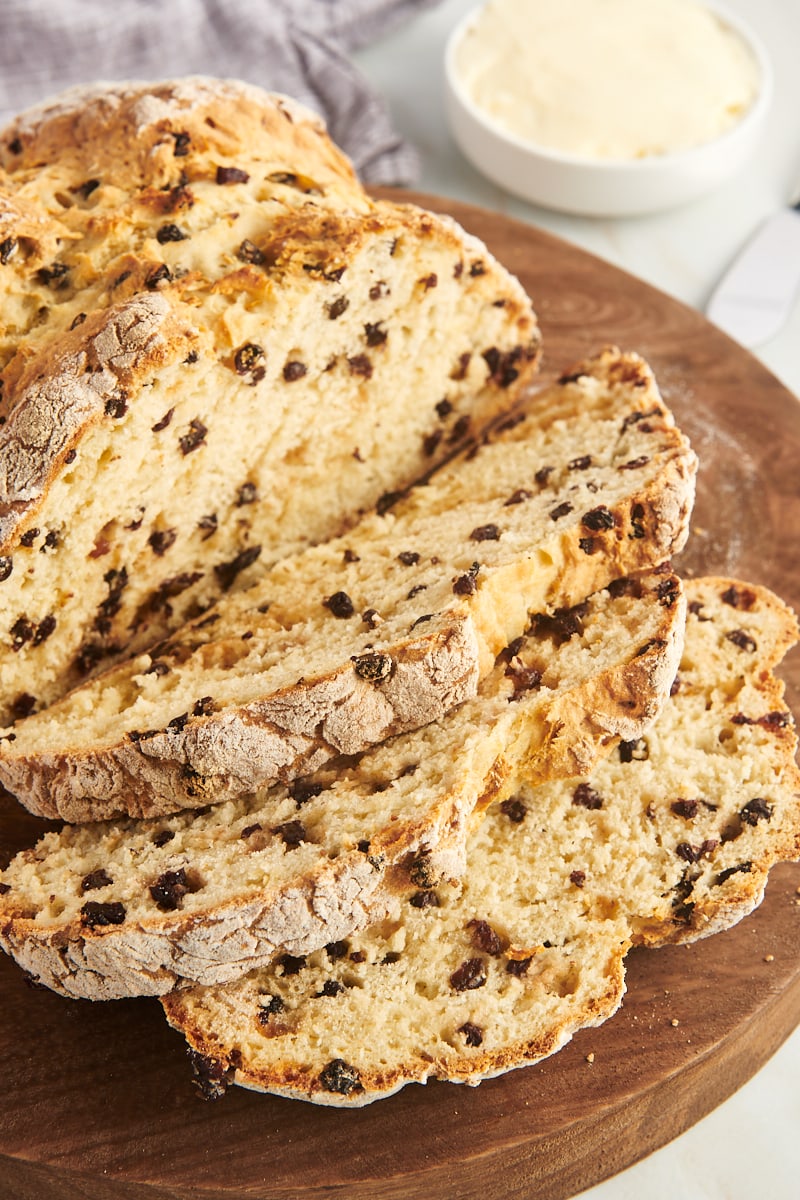
There’s something incredibly satisfying about baking your own bread, but we just don’t always have the time to make it. Luckily, this traditional Irish soda bread recipe offers the joy and pride of bread-making without the fuss, filling your home with the aroma of freshly baked bread. It’s wonderfully versatile, making it perfect for any occasion.
Why You’ll Love This Irish Soda Bread Recipe
- Uncomplicated ingredients. With just a handful of simple ingredients, this recipe turns the ordinary into the extraordinary. It’s accessible for everyone to bake and perfect for a stress-free baking project!
- No yeast, no wait. The magic of baking soda and buttermilk means you get a beautifully risen loaf in no time, perfect for when you crave fresh bread without the wait.
- Delightfully versatile. Whether you’re craving something sweet or savory, this bread adapts to your taste. Enjoy it plain, add dried fruits for a sweet touch, or incorporate herbs and cheese for a savory twist.
- Rustic charm. Each loaf is unique, with a beautiful, rustic appearance that looks as good as it tastes. It’s the kind of homemade bread that brings a cozy, comforting vibe to your kitchen.
What Is Irish Soda Bread?
Irish soda bread is a traditional quick bread from Ireland, known for its simplicity and rustic charm. Unlike other breads, it doesn’t require yeast, kneading, or lengthy rising times. Instead, it rises with the help of baking soda (hence the name) reacting with acidic buttermilk. The result is a dense, slightly tangy loaf with a distinctive soft interior and a crunchy crust.
Often made with just four ingredients—flour, baking soda, salt, and buttermilk—it embodies the essence of traditional Irish cooking: simple, hearty, and delicious. Simple variations include adding ingredients like dried fruits, nuts, or seeds for extra flavor and texture.
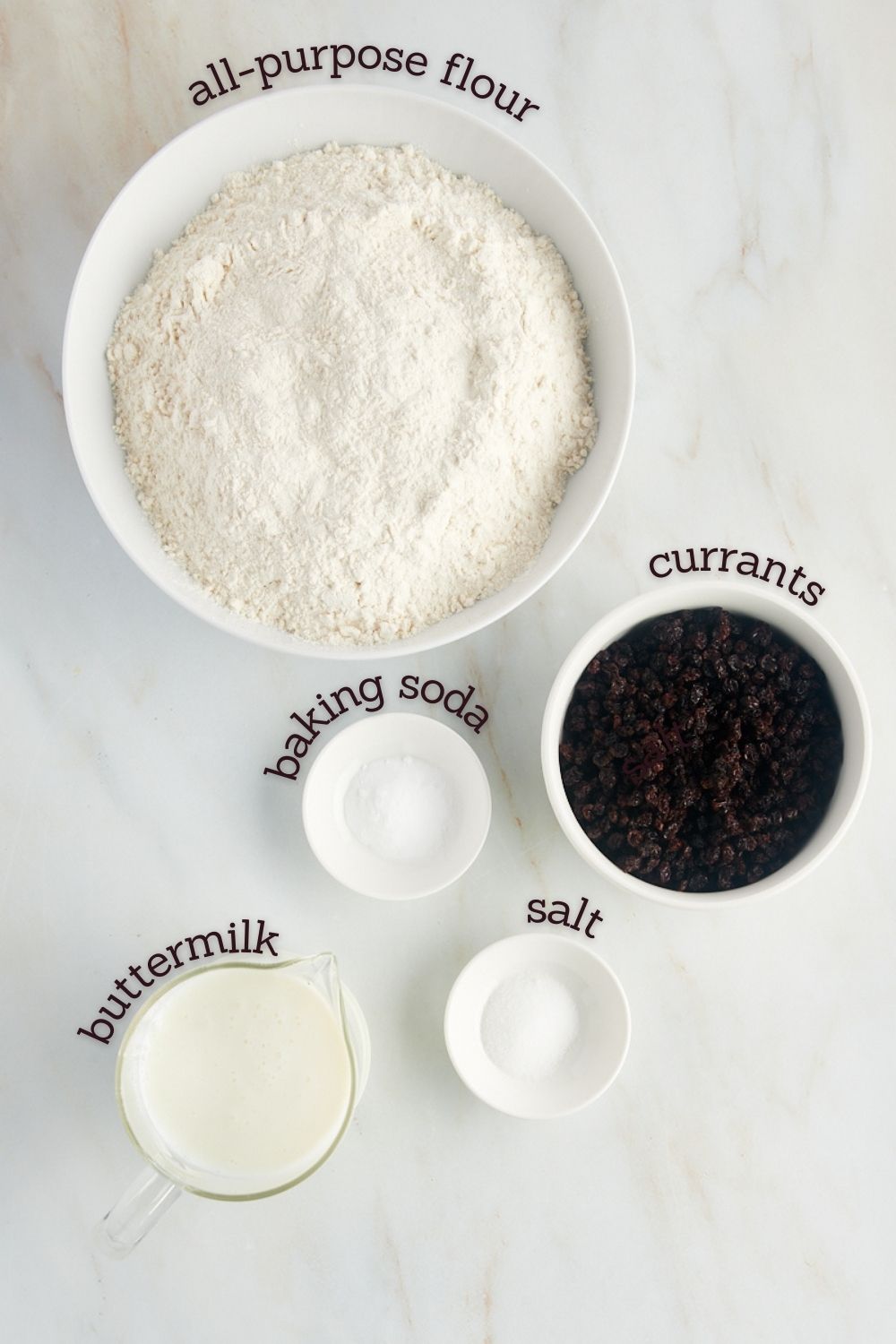
What You’ll Need
See the recipe card below for ingredient quantities and full instructions. Here are some notes about the ingredients:
- All-purpose flour – Measure by weight for the best results. If you don’t yet have a digital kitchen scale, use the spoon and sweep method. Learn more: How to Measure Flour
- Baking soda – This is what gives the bread its rise (and its name!).
- Salt – I usually just use regular table salt, but use whatever type you’d like.
- Buttermilk – This contributes to the bread’s texture, flavor, and rise.
- Dried currants – These are optional but add a hint of sweetness and extra flavor.
Can I Use a Buttermilk Substitute?
If you don’t have buttermilk on hand, then you can use a substitute. A common replacement involves mixing a tablespoon of lemon juice or white vinegar with a cup of milk for every cup of buttermilk listed in the recipe.
While this may work well enough, I recommend using buttermilk if possible. With this large amount of buttermilk, the variations in texture, flavor, and consistency will be more noticeable. Learn more and get other substitution options here: Buttermilk Substitutes
How to Make Irish Soda Bread
Whipping up this delicious homemade bread is a cinch! Here’s what you’ll need to do:
Make the Dough:

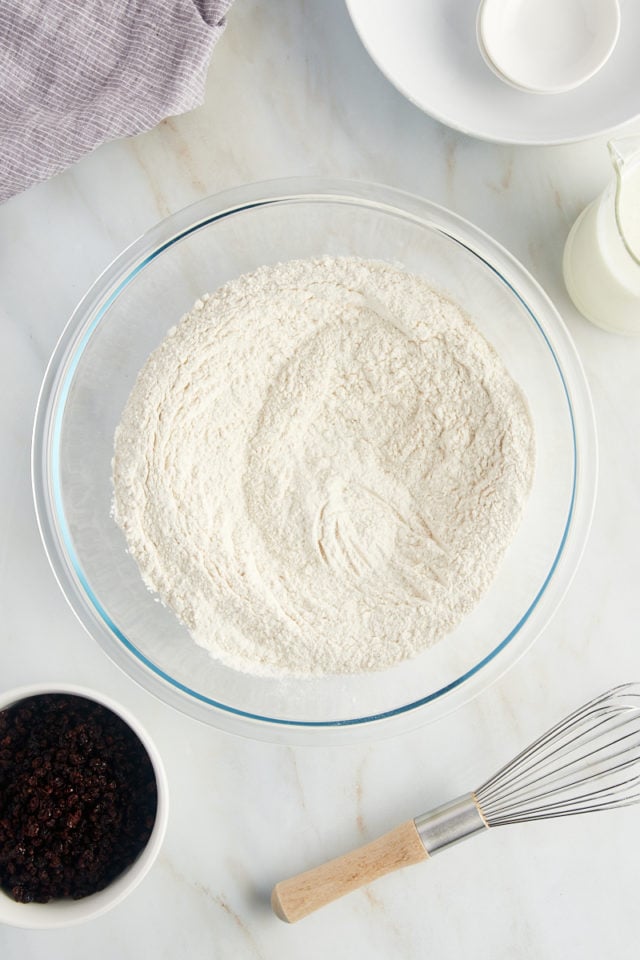
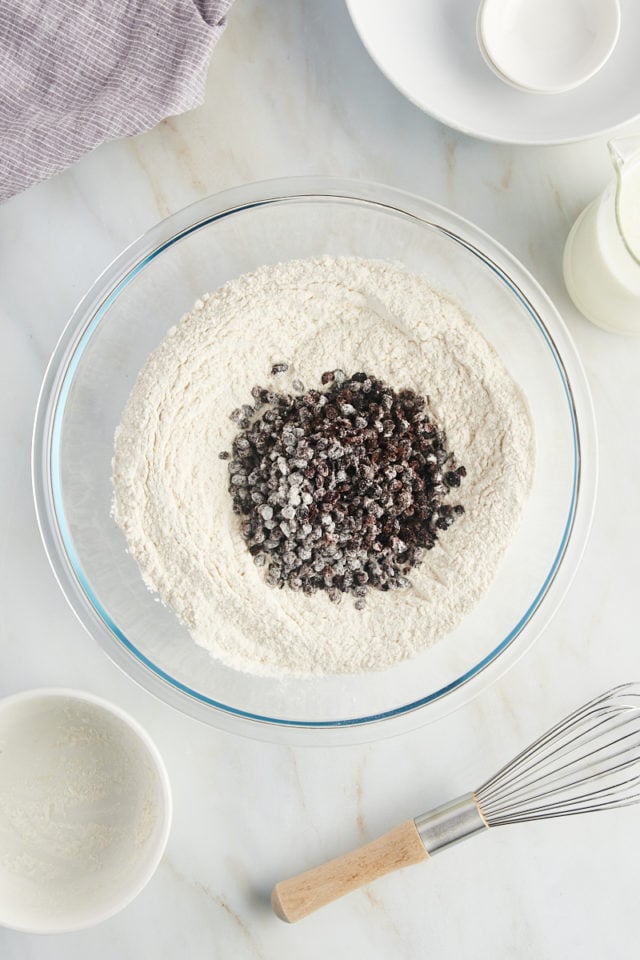
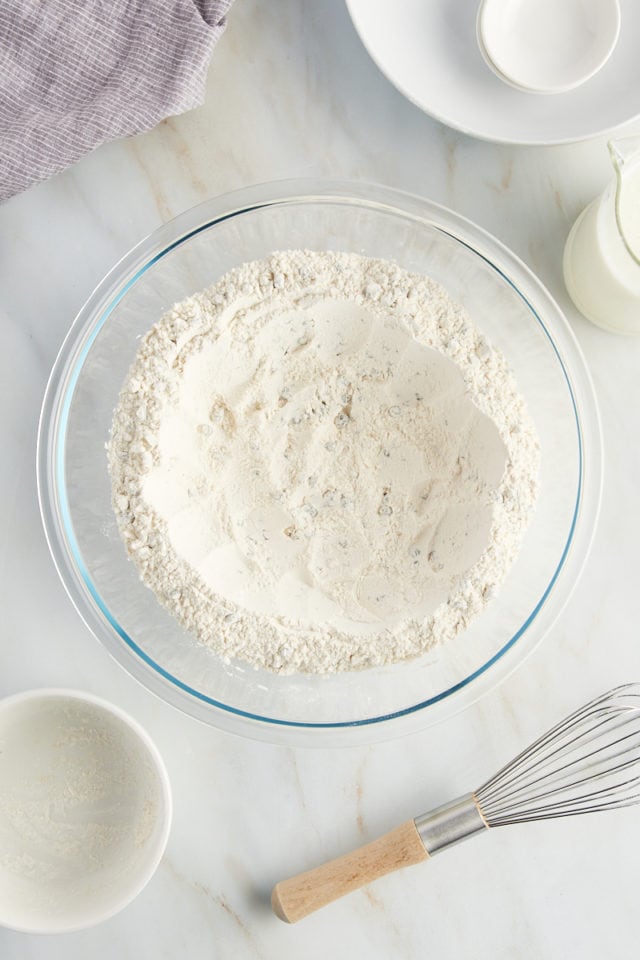
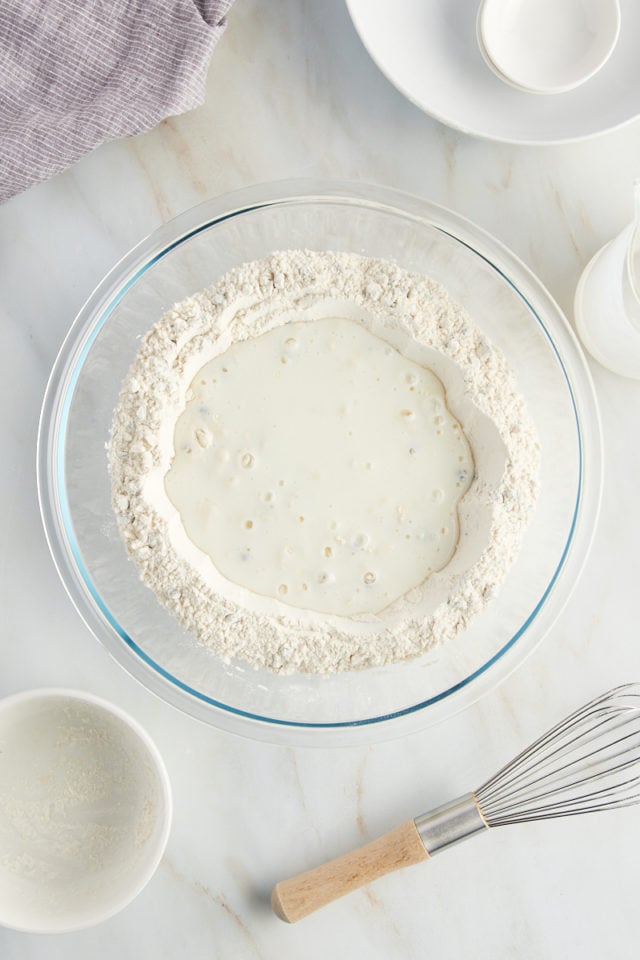
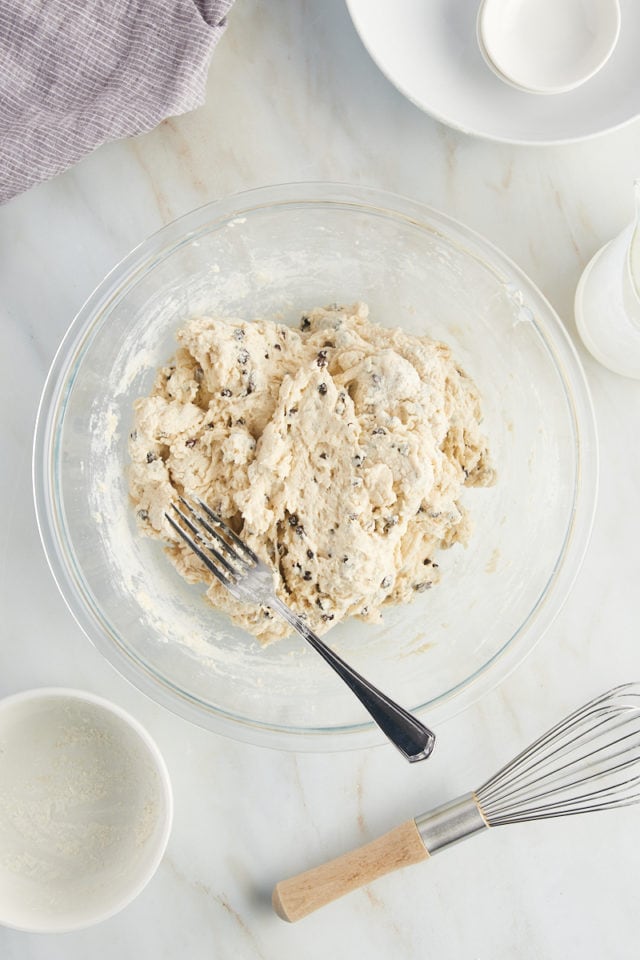
- Soak the dried fruit. If you’re using the currants or another dried fruit, place them in warm water for 10 to 15 minutes. Drain well and pat dry with a paper towel. This will help keep them from drawing moisture from the bread dough.
- Prepare for baking. Heat the oven to 425°F. Line a baking sheet with a silicone liner. If you have parchment paper that’s rated for high temperatures, you can use that to line your pan. Or you can instead skip the lining and lightly flour the baking sheet.
- Mix the dry ingredients. Whisk together the flour, baking soda, and salt in a large bowl. Toss the currants with a bit of the flour to help keep them from clumping, and then stir them into the remaining flour mixture.
- Mix in the buttermilk. Make a well in the center of the flour mixture, and then pour the buttermilk into the well. Mix with a fork or your hands until the dough begins to come together. The dough should be soft and not too sticky. If the dough is too sticky to handle, add more flour in small increments until it’s the right consistency.
Shape and Bake:

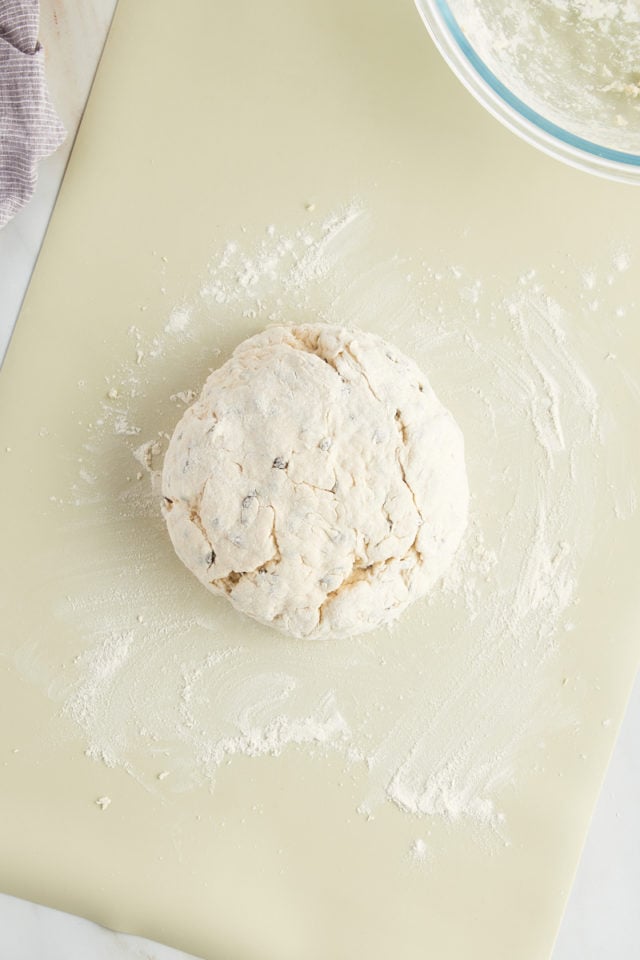
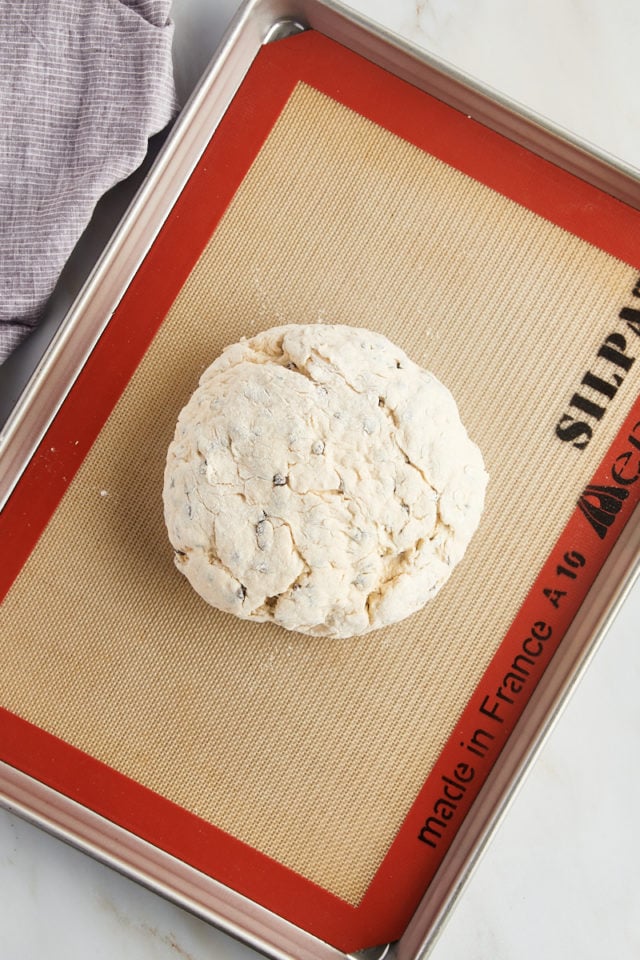

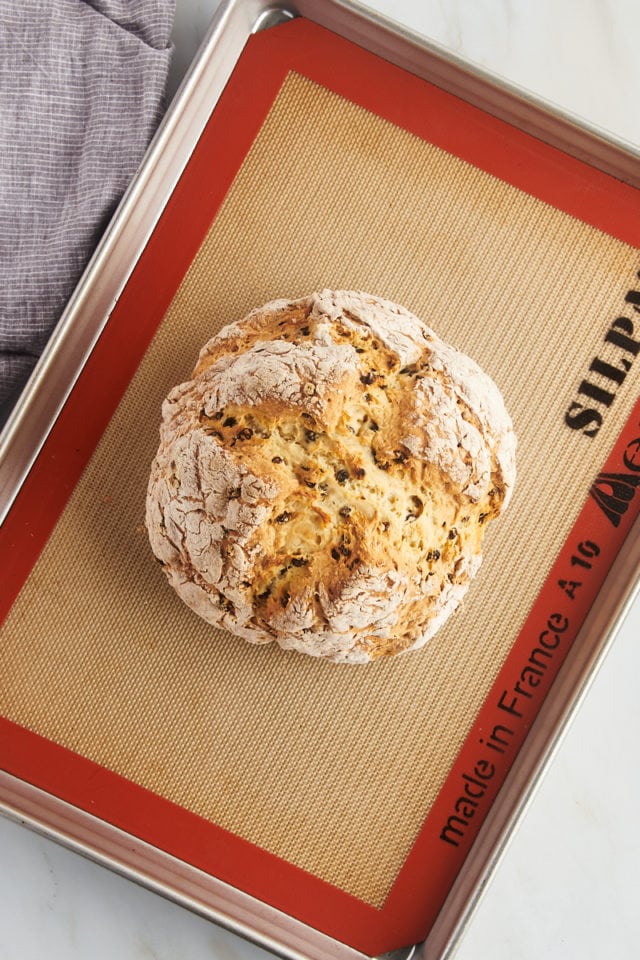
- Shape the bread. Place the dough on a floured work surface, and gently knead it just a few times to shape it into a round loaf. Transfer the dough onto the prepared pan, and then use a sharp knife to make a deep X cut in the top.
- Bake. Place the pan in the oven, and bake for 35 to 40 minutes. The bread should be golden brown and sound hollow when tapped. If you have an instant-read thermometer, aim for 190 to 220°F.
- Cool. Place the pan on a wire rack, and allow the bread to cool for at least 10 minutes before slicing.
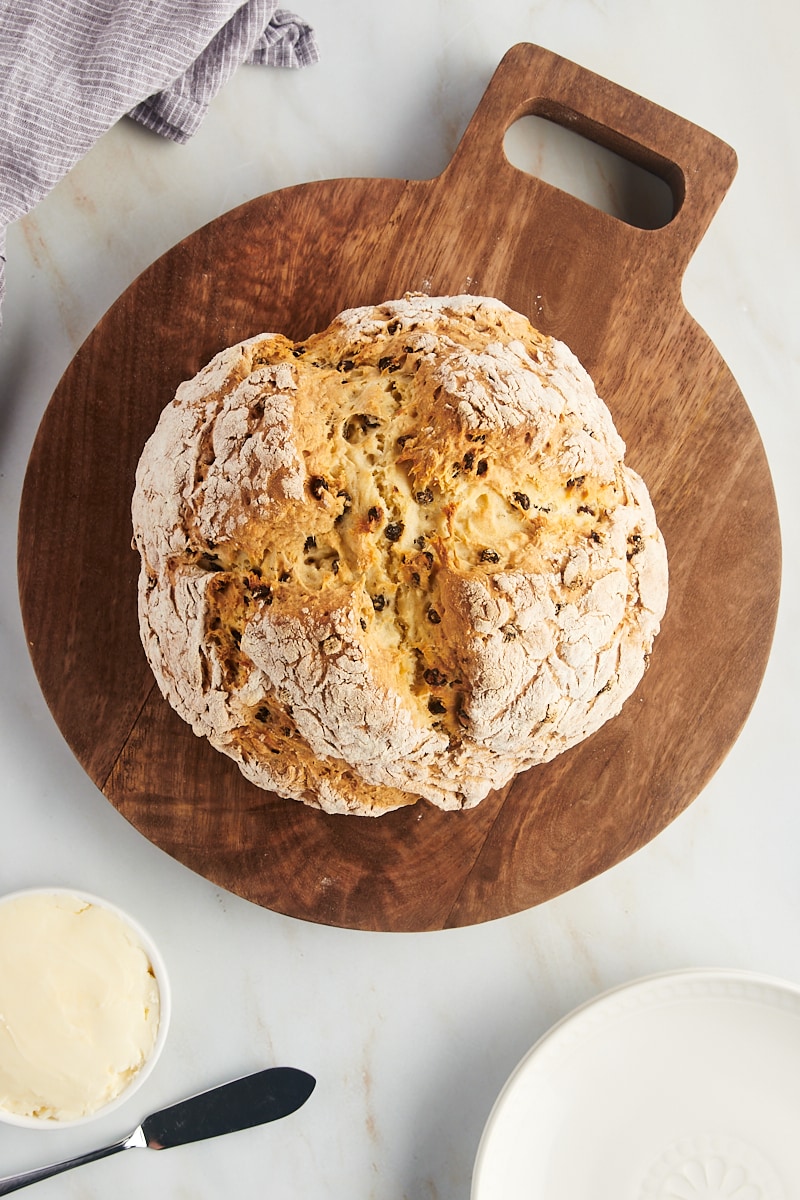
Tips for Success
Before you start baking, read over these tips to help make sure your Irish soda bread turns out perfectly.
- Don’t over-mix. Mix the ingredients until just combined to avoid making the bread tough. Using a fork to mix lets you gently mix the dough without overdoing it.
- Use cold buttermilk. Cold buttermilk reacts with baking soda to create the leavening gas more effectively when it hits the oven’s heat, contributing to a good rise and airy texture.
- Consider humidity. Like many bread recipes, humidity can affect the dough. If your dough is too wet and sticky to handle, add more flour in small increments until it’s the right consistency. Remember, you’re aiming for a soft dough that’s only slightly sticky. Be conservative and remember that it’s easier to add more flour than to correct a dough that’s too dry.
- Flour your surface generously. When shaping the dough, use a well-floured surface to prevent sticking without adding too much extra flour to the dough, which could dry it out.
- Score the bread. Cutting a deep X or cross on top of the dough before baking helps it to expand freely and bake more evenly in the center.
- Check for doneness. The bread is done when it has a golden-brown crust and sounds hollow when tapped on the bottom. An instant-read thermometer inserted into the center should read 190°F to 200°F.

Variations
There are many ways to customize this simple quick bread. I often use dried currants, but other dried fruits like raisins or cranberries are good choices, too. You can also try adding chopped nuts or seeds (like sunflower, pumpkin, or caraway seeds) for different flavors and textures. Just be sure to coat them in a little flour to help prevent them from sinking to the bottom. For a heartier savory version, skip the dried fruits in favor of shredded cheese and add about 2 tablespoons of chopped herbs.

Serving Suggestions
I think you’ll find that this simple Irish soda bread is quite versatile. Whether it’s part of a meal or a simple snack, its comforting texture and flavor are always a hit. Here are some ideas for serving it to get you started:
- Breakfast – Serve warm slices of Irish soda bread with butter and jam for a simple yet satisfying breakfast.
- Soup companion – A slice of this bread makes the perfect companion to creamy soups or hearty stews. Its dense texture is ideal for soaking up flavors.
- Cheese board – Include slices or chunks of the bread on a cheese board. Its subtle tang and firm texture complement a wide range of cheeses, from sharp cheddar to soft brie.
- Sandwiches – Use thick slices of the bread to make open-faced sandwiches.
- Tea time – Irish soda bread can be a delightful addition to an afternoon tea spread, especially if you’ve added dried fruits to the dough.
- Customized toppings – Experiment with various toppings like honey, nut butter, or a sprinkle of cinnamon sugar.
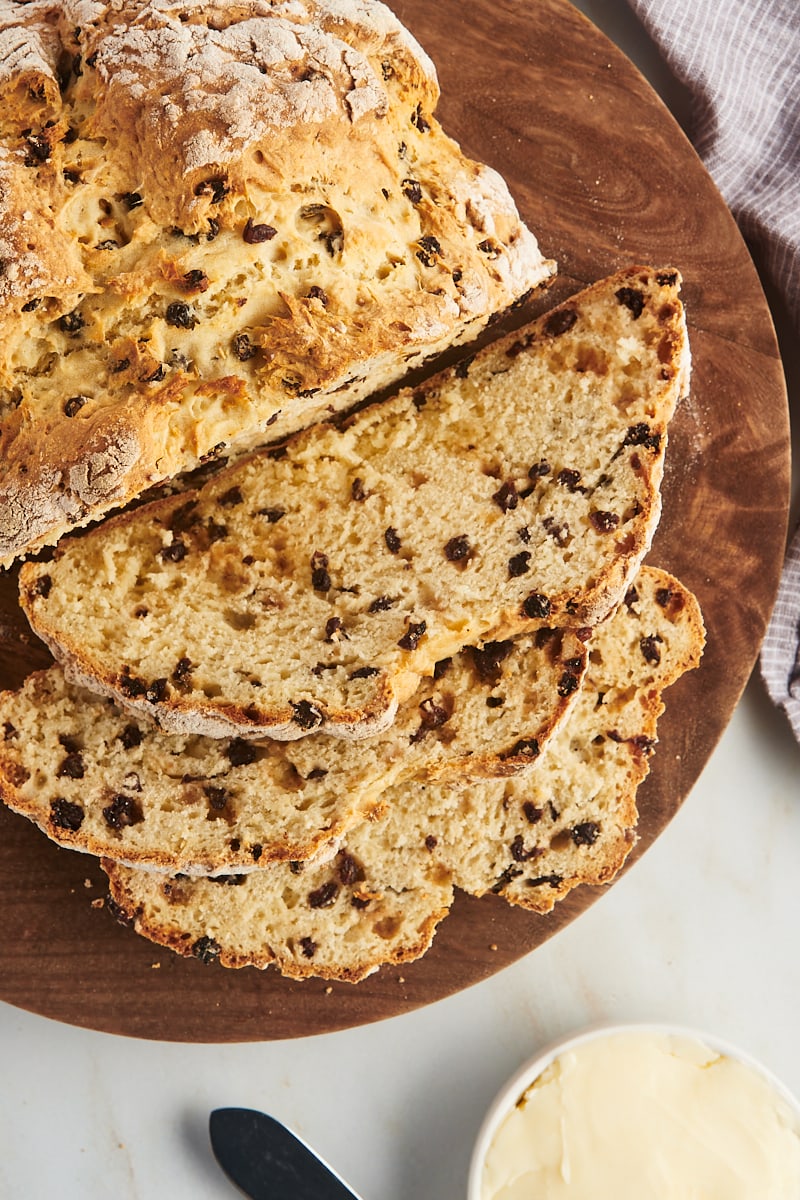
How to Store
Irish soda bread is best enjoyed the day it’s made, but it can be wrapped tightly and stored at room temperature for a day or two. To refresh, simply warm it in the oven for a few minutes.
How to Freeze
This bread freezes quite well. After it has cooled completely, wrap the bread (individual slices or the whole loaf) tightly in plastic wrap. Place inside an airtight freezer container or bag. Properly stored, it should keep in the freezer up to 3 months. Thaw at room temperature, or warm it in a 350°F oven for about 10 minutes.
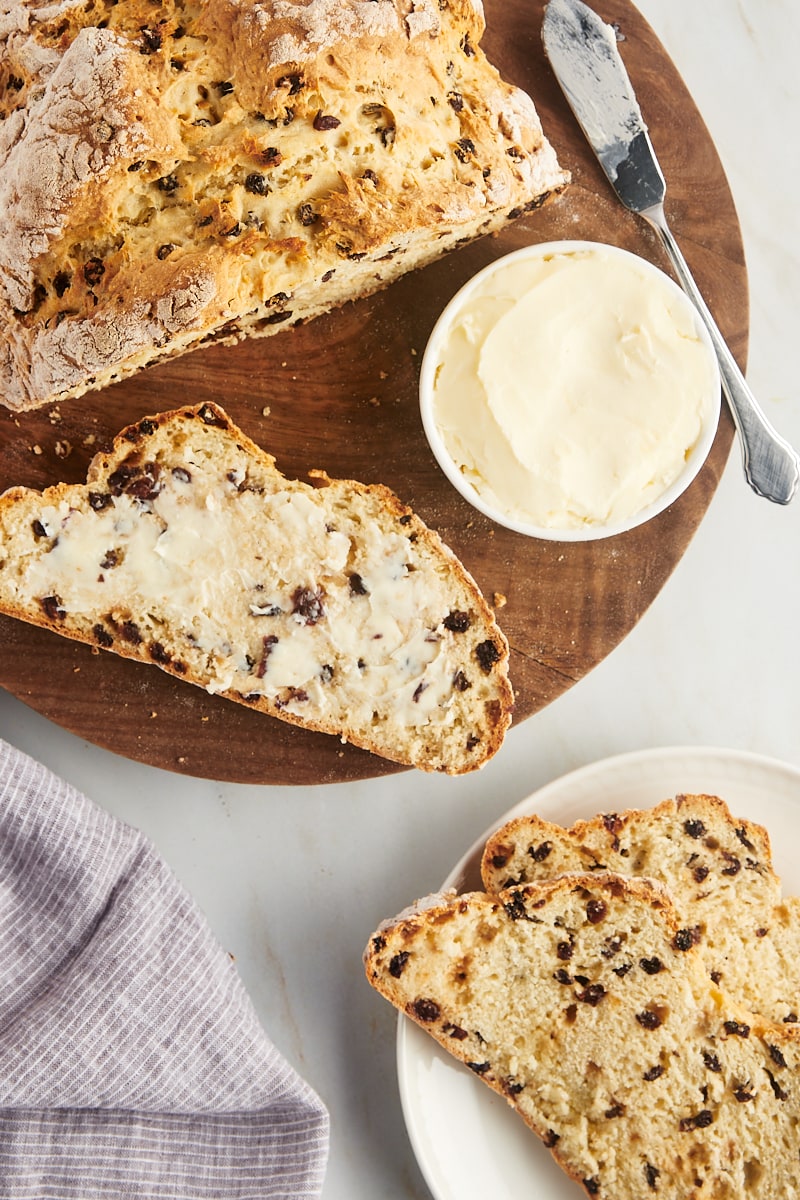
More Easy Bread Recipes
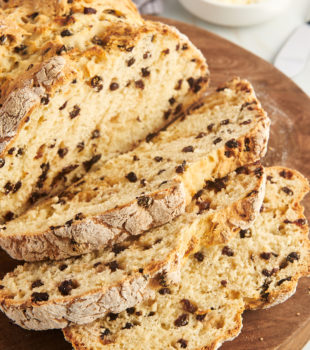
Irish Soda Bread
Ingredients
- 1 cup dried currants or raisins, optional
- 4 cups (480 g) all-purpose flour, plus more for kneading and shaping the dough
- 1 teaspoon baking soda
- 1 teaspoon salt
- 1 3/4 cups (420 ml) buttermilk
Recommended Products
Instructions
- If using the dried fruit, soak it in warm water for about 10-15 minutes. Drain well and pat dry with a paper towel to remove any excess moisture.
- Preheat the oven to 425°F (220°C). Lightly flour a baking sheet or line it with a silicone liner.
- Whisk together the flour, baking soda, and salt. Toss the currants with a bit of the flour, and then stir them into the flour mixture.
- Make a well in the center of the flour mixture and pour in the buttermilk. Stir with a fork or your hands until the dough begins to come together. It should be soft, but not too sticky. If it's too wet, add more flour in small amounts until the dough is the correct consistency.
- Turn the dough out onto a lightly floured surface and gently knead it a few times to bring it together into a round loaf. Be careful not to over-knead, as this can make the bread tough.
- Place the dough on the prepared baking sheet and use a sharp knife to cut a deep X into the top to help the bread to expand and bake evenly.
- Bake for 35 to 40 minutes, or until the bread is golden brown and sounds hollow when tapped. If you'd like to test for doneness with an instant-read thermometer, the center of the bread should be about 190 to 200°F (88 to 93°C).
- Remove the bread from the oven and let it cool on a wire rack for about 10 minutes before slicing.
Notes
- Irish soda bread will be at its best when it’s fresh, but it can be stored in an airtight container at room temperature up to 2 days.

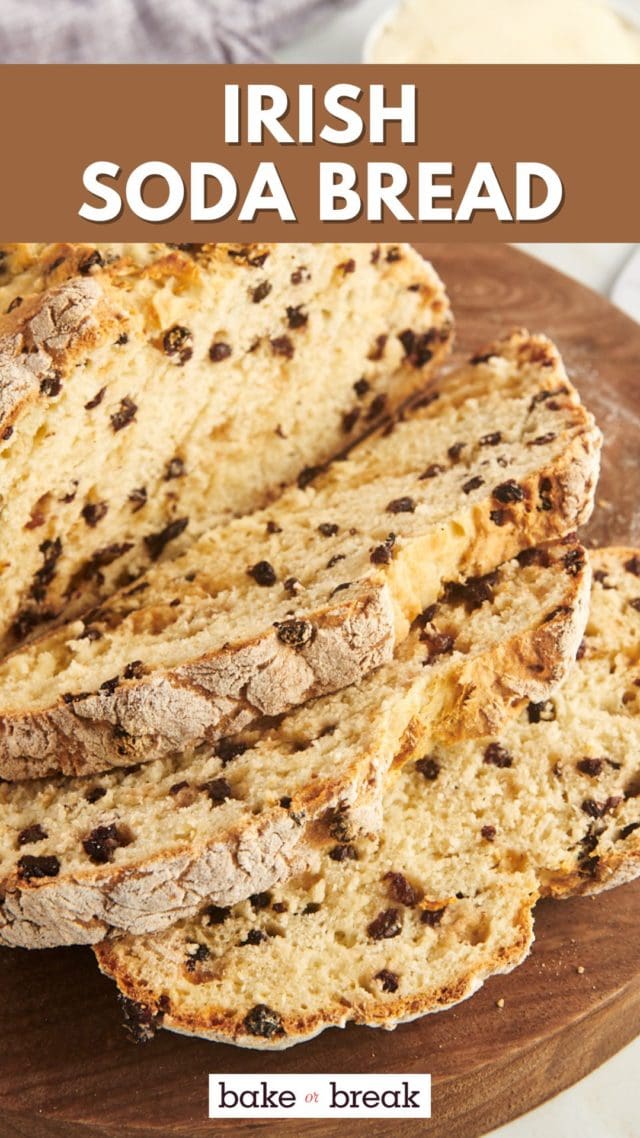
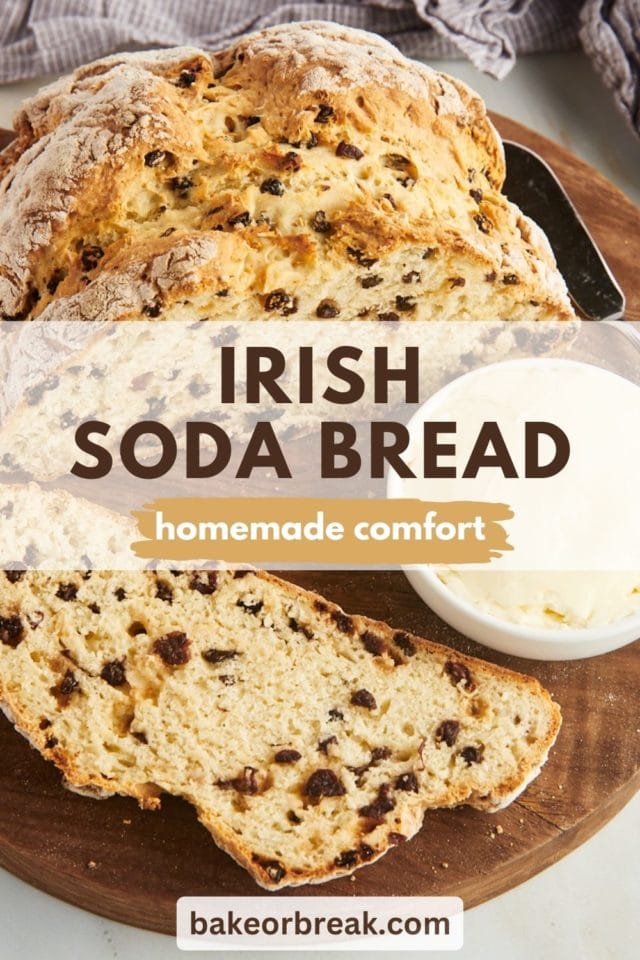
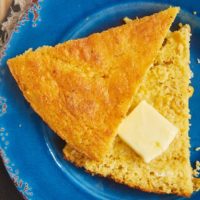

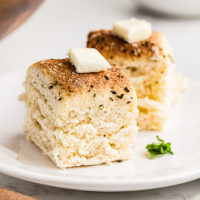
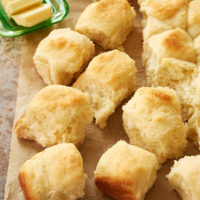

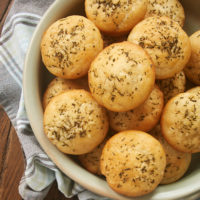
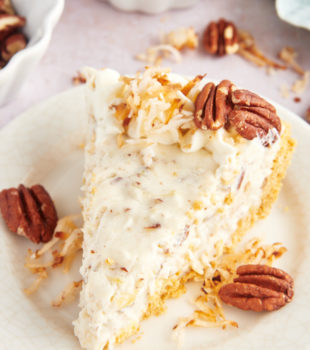

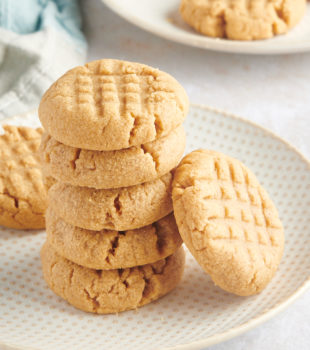


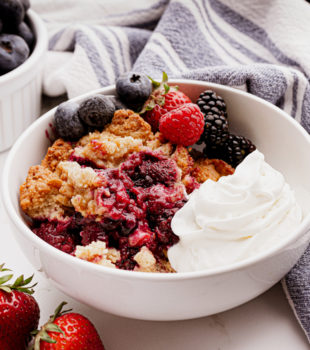
3 Comments on “Irish Soda Bread”
Hey, Jennifer! I made this on Saint Patrick’s Day and simply forgot to post this until now. I added walnuts to the dough, instead of raisins or currants. After it finished baking, I let it cool completely and then cut it into thick slices and made toast with it. Holy moly, it was divine!!!! I’ll try a mix of currants and walnuts next time! Great recipe 😊
I’m so glad you liked the bread! It’s such an easy thing to whip up when you’re craving homemade bread. I somehow haven’t tried it yet with nuts, but I must give that a try!
This reminded me so much of my mom’s soda bread growing up it looks just like it and I have to admit I’ve never made it myself, I sadly haven’t even thought about it in so long. The smell while it was baking took me back. That crust on the outside, that soft on the inside. Thanks so much for sharing this and inspiring me to do a little time traveling!